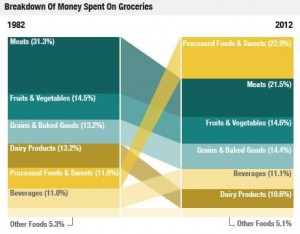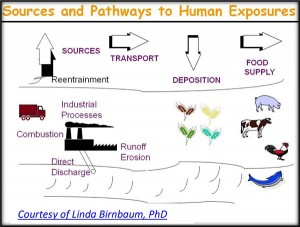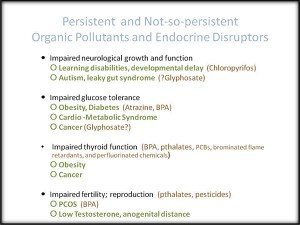Calories, Carbs and Contaminants: The Endocrine Disruptors in Our Foods
Today we grapple with an abundant and adulterated food supply compared to just a couple generations ago with more consumers looking to purchase whole foods and eating as close to the earth as they can.
 They bank on clean eating to minimize risk of disease, as well as support their health and quality of life. Nutrition food labels help consumers assess everything from calories to carbohydrates, ingredient lists determine if a food contains harmful additives or not.
They bank on clean eating to minimize risk of disease, as well as support their health and quality of life. Nutrition food labels help consumers assess everything from calories to carbohydrates, ingredient lists determine if a food contains harmful additives or not.
As a result, a whole new product line known as “Free from foods” draws in consumers with the promise to reduce exposure to “generally regarded as safe” (GRAS) food additives that are increasingly called into question. Partially hydrogenated fats have already been targeted, and emerging research suggests that emulsifiers and artificial sweeteners are known to disrupt gut microbes.
HOW WE GROW FOOD MATTERS
Once consumers learned to pay attention to nutrition, they soon learned they also needed to pay attention to how food is grown. Consumers shop to minimize their family’s exposure to pesticide and other chemical residues from intensive chemical farming. Consumers also choose locally grown and sustainably grown foods, most typically to protest the environmental harm of industrial agriculture.
While consumers allocate more food dollars to purchase “Free from” and organic food segment in the marketplace. they are learning that even that may not be enough.
THE BODY BURDEN OF ENDOCRINE DISRUPTORS
Scientists estimate that up to ninety five percent of the substances known as persistent organic pollutants (POPs) enter in the body via the food supply. Some POPS are known as endocrine disruptors which disrupt critical metabolic processes. The presence of endocrine disruptors in the food supply is a rather new phenomena, reflecting the impact of industrialization, the advent of the plastics industry, and current farming practices.

In this way, the chemicals bio-accumulate up the food chain, with the greatest concentration typically found in fat stores of animals and humans eating at the top. The range and total amount of these chemicals accumulate in all living organisms is known as the “body burden.”
ENDOCRINE DISRUPTORS IMPACT ON HUMAN HEALTH
A 2012 WHO document regarding endocrine disruptors reports, “Close to 800 chemicals are known or suspected to be capable of interfering with hormone receptors, hormone synthesis or hormone conversion.” While in 2002 the authors of the report claimed that there was little evidence of harm to human health, the 2012 updated reports states that “data linking exposures to EDCs and human diseases are much stronger now than in 2002…”

We all carry a body burden.
A wide range of conditions and diseases link to exposure to pesticides and herbicides used in commercial and home applications, plastics, and other chemical compounds. I prepared this slide for a presentation at the California Dietetic Association in April, 2015, and the list is by no means exhaustive.
Despite the ominous implications, governments and health care institutions exhibit a wide range of responses. Linda Birnbaum, current director of the National Institute for Environmental Health Sciences, as well as the National Toxicology Program, shared how the Swedish government responded to increasing levels of contaminants in breast milk at a conference which introduced me to the concept of endocrine disruptors in the food supply at Loma Linda University in 2002.
The Swedes had incredibly collected and maintained a breast milk bank over decades. Most endocrine disruptors are lipophilic, which means that they preferentially accumulate in fat stores. At 50% fat content, breast milk is an ideal depot to measure bio-accumulation. As scientists and government officials noted the escalating concentration of contaminants in the collected breast milk, they banned the offending agents and within 5 years a sharp decrease could be measured.
Unfortunately, both our federal and state government regulatory agencies continue to dither with the data today. They often fail to enact materially significant changes until communities and environmental agencies press for action in the courts. However, there seems to be some momentum to change this dismal state of affairs.
California banned the use of fire retardants known as PBDEs in clothing, textiles and furniture in 2003, with activation in 2006. In 2014 California regulators also proposed heavy restrictions on the agricultural use of the pesticide Choripyrifos. By October of 2015 the Environmental Protection Agency also called for zero tolerance of residues of Choripyrifos in food, a pesticide linked to neurological damage in farm workers, as reported in the Los Angeles Times.
THE FUTURE OF FOOD
In all likelihood we are just seeing the tip of the iceberg. Research will continue linking chemical contamination with a wide range of diseases, from asthma and allergies to cancer, but consumers can take action. Dr. Frank Lipman provides an excellent list of suggestions to limit endocrine disruptor exposure in the kitchen and limit endocrine disruptor exposure in your household.
Thankfully in 2012 many scientists called for “Fundamental changes in chemical testing and safety… needed to protect human health,” even as Big Chem characterizes their findings as sensational science, and has historically blocked the kind of restrictions seen in Canada and Europe. Communities, watchdog agencies, and consumers need to stay vigilant. Each of us votes with our dollars, so continue to purchase carefully.
